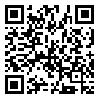Volume 77, Issue 4 (July 2019)
Tehran Univ Med J 2019, 77(4): 257-266 |
Back to browse issues page
Download citation:
BibTeX | RIS | EndNote | Medlars | ProCite | Reference Manager | RefWorks
Send citation to:



BibTeX | RIS | EndNote | Medlars | ProCite | Reference Manager | RefWorks
Send citation to:
Alami A, Zarei F, Tehrani H, Hosseini Z, Jafari A. Perceived challenges of the schools iron aid national plan from stakeholder perspectives. Tehran Univ Med J 2019; 77 (4) :257-266
URL: http://tumj.tums.ac.ir/article-1-9771-en.html
URL: http://tumj.tums.ac.ir/article-1-9771-en.html
1- Department of Public Health, School of Public Health, Social Determinants of Health Research Center, Gonabad University of Medical Sciences, Gonabad, Iran.
2- Department of Health Education, Faculty of Medical Sciences, Tarbiat Modares University, Tehran, Iran.
3- Department of Health Education & Health Promotion, Social Determinants of Health Research Center Mashhad University of Medical Sciences, School of Public Health, Mashhad, Iran.
4- Department of Public Health, School of Public Health, Social Determinants of Health Research Center, Gonabad University of Medical Sciences, Gonabad, Iran. ,jafari.ar94@gmail.com
2- Department of Health Education, Faculty of Medical Sciences, Tarbiat Modares University, Tehran, Iran.
3- Department of Health Education & Health Promotion, Social Determinants of Health Research Center Mashhad University of Medical Sciences, School of Public Health, Mashhad, Iran.
4- Department of Public Health, School of Public Health, Social Determinants of Health Research Center, Gonabad University of Medical Sciences, Gonabad, Iran. ,
Abstract: (2706 Views)
Background: Iron deficiency in the body is the main cause of anemia, and iron supplementation is probably the best option for iron deficiency and iron deficiency anemia in women and young children. This study aimed to explain the challenges of national iron supplementation in female school’s base on the perspective of the stakeholders.
Methods: This study was a qualitative study of content analysis. The data of this study were conducted by focus group discussion, semi-deep interviews with the participation of the target community of students, parents of students, school principals and school health instructors, general manager of the Office of Community Nutrition (Department of Education) includes manager, deputy and school health officer, from October 2016 to January 2017 in city of Gonabad, Iran. Participants were selected through targeted sampling and data collection continued to saturation. Data were analyzed using contractual content analysis method based on five steps of Graneheim and Lundman. Data management was done with NVivo software, version 11 (QSR International, Victoria, Australia), but data analysis and interpretation were done manually.
Results: The findings from group discussions and semi-deep interviews with stakeholders were categorized into twelve themes. The main strength, perceived in "Perceived Individual Benefits" and "Perceived Executive or Management Benefits". The main perceived weakness was "Physical Disadvantages", "Tablets Disadvantages", "Disadvantages of Programming" and "Disadvantages of the Program". The main perceived barriers was "Educational and Information Barriers", "Barriers of Pill Consumption" and "Management and Administrative Barriers". "Modifying the Executive Program", "Individual Perception Modification" and "Reform the Shape of Pills" were suggested as a corrective mechanism from participants’ view point.
Conclusion: According to the results of this study, the most important challenges of the "Schools Iron Aid National Plan" were "Educational and Information Barriers", "Administrative barriers", and "Barriers to Pill Consumption". Therefore, in order to do better, the Iron Supplementation Program requires intervention at individual, interpersonal, inter-organizational, and intra-organizational levels to provide comprehensive support for the program and, ultimately, increase program productivity.
Methods: This study was a qualitative study of content analysis. The data of this study were conducted by focus group discussion, semi-deep interviews with the participation of the target community of students, parents of students, school principals and school health instructors, general manager of the Office of Community Nutrition (Department of Education) includes manager, deputy and school health officer, from October 2016 to January 2017 in city of Gonabad, Iran. Participants were selected through targeted sampling and data collection continued to saturation. Data were analyzed using contractual content analysis method based on five steps of Graneheim and Lundman. Data management was done with NVivo software, version 11 (QSR International, Victoria, Australia), but data analysis and interpretation were done manually.
Results: The findings from group discussions and semi-deep interviews with stakeholders were categorized into twelve themes. The main strength, perceived in "Perceived Individual Benefits" and "Perceived Executive or Management Benefits". The main perceived weakness was "Physical Disadvantages", "Tablets Disadvantages", "Disadvantages of Programming" and "Disadvantages of the Program". The main perceived barriers was "Educational and Information Barriers", "Barriers of Pill Consumption" and "Management and Administrative Barriers". "Modifying the Executive Program", "Individual Perception Modification" and "Reform the Shape of Pills" were suggested as a corrective mechanism from participants’ view point.
Conclusion: According to the results of this study, the most important challenges of the "Schools Iron Aid National Plan" were "Educational and Information Barriers", "Administrative barriers", and "Barriers to Pill Consumption". Therefore, in order to do better, the Iron Supplementation Program requires intervention at individual, interpersonal, inter-organizational, and intra-organizational levels to provide comprehensive support for the program and, ultimately, increase program productivity.
Type of Study: Original Article |
Send email to the article author
| Rights and permissions | |
 |
This work is licensed under a Creative Commons Attribution-NonCommercial 4.0 International License. |





